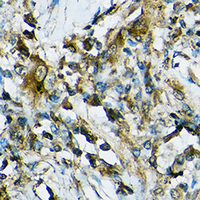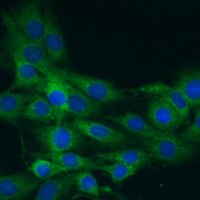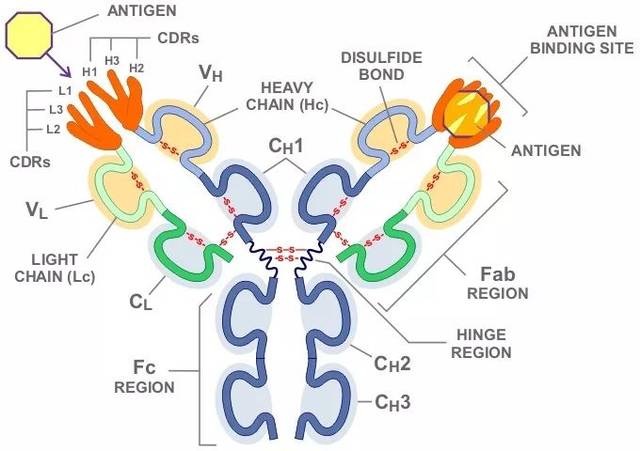Product Name :
NLRP1 polyclonal antibody Background :
NALP1 (DEFCAP/NAC/CARD7) is an NLR (Nod-like receptor) family member that has been implicated in the regulation of apoptosis and inflammatory responses. Structurally, NALP contains an amino-terminal PYRIN domain, followed by a nucleotide-binding site (NBS), a leucine-rich repeat region (LRR), and a carboxy-terminal CARD domain. NALP1 interacts strongly with caspase-2 and weakly with caspase-9, and induces apoptosis when overexpressed. Similar to a related Ced-4 family member Apaf-1, it was also shown to be involved in cytochrome c-dependent caspase activation. It has also been shown to be part of the "inflammasome" comprised of caspase-1, caspase-5, and Pycard/ASC, which is critical in the processing of pro-inflammatory cytokines like IL-1β. Two major isoforms were identified for NALP1, which differ in a 44 amino acid region within the LRR. In addition, like NALP3, a short NALP1 isoform lacking the LRR (NALP1s) likely exists. Polymorphisms in NALP1 have been associated with autoimmune diseases and susceptibility to toxins. NALP1 is autoproteolytically processed into a large N-terminal and a small C-terminal fragment, which are non-covalently associated. Upon activation, the C-terminal is released and forms inflammasomes with other proteins. Product :
Liquid in 0.42% Potassium phosphate, 0.87% Sodium chloride, pH 7.3, 30% glycerol, and 0.01% sodium azide. Storage&Stability :
Store at 4°C short term. Aliquot and store at -20°C long term. Avoid freeze-thaw cycles. Specificity :
Recognizes endogenous levels of NLRP1 protein. Immunogen :
Recombinant protein corresponding to human NLRP1. The exact sequence is proprietary. Conjugate :
Unconjugated Modification :
Unmodification
NLRP1 polyclonal antibody Background :
NALP1 (DEFCAP/NAC/CARD7) is an NLR (Nod-like receptor) family member that has been implicated in the regulation of apoptosis and inflammatory responses. Structurally, NALP contains an amino-terminal PYRIN domain, followed by a nucleotide-binding site (NBS), a leucine-rich repeat region (LRR), and a carboxy-terminal CARD domain. NALP1 interacts strongly with caspase-2 and weakly with caspase-9, and induces apoptosis when overexpressed. Similar to a related Ced-4 family member Apaf-1, it was also shown to be involved in cytochrome c-dependent caspase activation. It has also been shown to be part of the "inflammasome" comprised of caspase-1, caspase-5, and Pycard/ASC, which is critical in the processing of pro-inflammatory cytokines like IL-1β. Two major isoforms were identified for NALP1, which differ in a 44 amino acid region within the LRR. In addition, like NALP3, a short NALP1 isoform lacking the LRR (NALP1s) likely exists. Polymorphisms in NALP1 have been associated with autoimmune diseases and susceptibility to toxins. NALP1 is autoproteolytically processed into a large N-terminal and a small C-terminal fragment, which are non-covalently associated. Upon activation, the C-terminal is released and forms inflammasomes with other proteins. Product :
Liquid in 0.42% Potassium phosphate, 0.87% Sodium chloride, pH 7.3, 30% glycerol, and 0.01% sodium azide. Storage&Stability :
Store at 4°C short term. Aliquot and store at -20°C long term. Avoid freeze-thaw cycles. Specificity :
Recognizes endogenous levels of NLRP1 protein. Immunogen :
Recombinant protein corresponding to human NLRP1. The exact sequence is proprietary. Conjugate :
Unconjugated Modification :
Unmodification
-
 Western blot analysis of NLRP1 expression in SHSY5Y (A) whole cell lysates.
Western blot analysis of NLRP1 expression in SHSY5Y (A) whole cell lysates. -
 Immunohistochemical analysis of NLRP1 staining in human lung cancer formalin fixed paraffin embedded tissue section. The section was pre-treated using heat mediated antigen retrieval with sodium citrate buffer (pH 6.0). The section was then incubated with the antibody at room temperature and detected using an HRP conjugated compact polymer system. DAB was used as the chromogen. The section was then counterstained with haematoxylin and mounted with DPX.
Immunohistochemical analysis of NLRP1 staining in human lung cancer formalin fixed paraffin embedded tissue section. The section was pre-treated using heat mediated antigen retrieval with sodium citrate buffer (pH 6.0). The section was then incubated with the antibody at room temperature and detected using an HRP conjugated compact polymer system. DAB was used as the chromogen. The section was then counterstained with haematoxylin and mounted with DPX. -
 Immunohistochemical analysis of NLRP1 staining in human lung cancer formalin fixed paraffin embedded tissue section. The section was pre-treated using heat mediated antigen retrieval with sodium citrate buffer (pH 6.0). The section was then incubated with the antibody at room temperature and detected using an HRP conjugated compact polymer system. DAB was used as the chromogen. The section was then counterstained with haematoxylin and mounted with DPX.
Immunohistochemical analysis of NLRP1 staining in human lung cancer formalin fixed paraffin embedded tissue section. The section was pre-treated using heat mediated antigen retrieval with sodium citrate buffer (pH 6.0). The section was then incubated with the antibody at room temperature and detected using an HRP conjugated compact polymer system. DAB was used as the chromogen. The section was then counterstained with haematoxylin and mounted with DPX.
Bioworld Biotech only provide peptides for our antibodies and do not provide additional peptide customization services.
Price/Size :
USD 368/1mg/vial
Tips:
For phospho antibody, we provide phospho peptide(0.5mg) and non-phospho peptide(0.5mg).Describe :
Blocking peptides are peptides that bind specifically to the target antibody and block antibody binding. These peptide usually contains the epitope recognized by the antibody. Antibodies bound to the blocking peptide no longer bind to the epitope on the target protein. This mechanism is useful when non-specific binding is an issue, for example, in Western blotting (WB) and Immunohistochemistry (IHC). By comparing the staining from the blocked antibody versus the antibody alone, one can see which staining is specific; Specific binding will be absent from the western blot or IHC performed with the neutralized antibody.Formula:
Synthetic peptide was lyophilized with 100% acetonitrile and is supplied as a powder. Reconstitute with 0.1 ml DI water for a final concentration of 10 mg/ml.The purity is >90%,tested by HPLC and MS.
Storage:
The freeze-dried powder is more stable. For short time at 2-8°C. For long term storage store at -20°C.
Note :
This product is for research use only (RUO only). Not for use in diagnostic or therapeutic procedures.
 NLRP1 polyclonal antibody
NLRP1 polyclonal antibody  Datasheet
Datasheet COA
COA MSDS
MSDS SHIP
SHIP